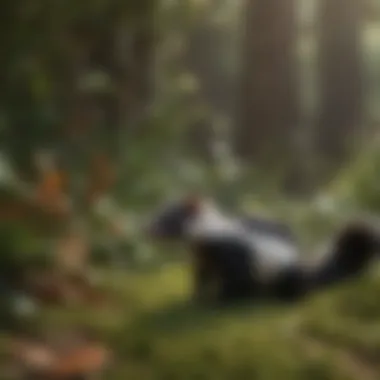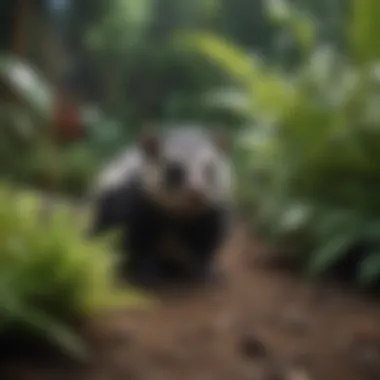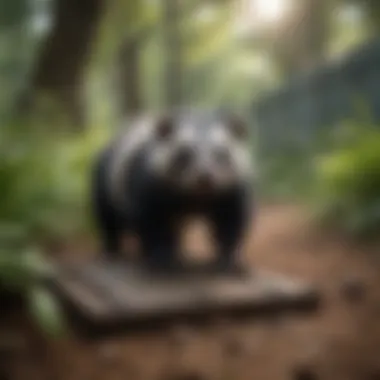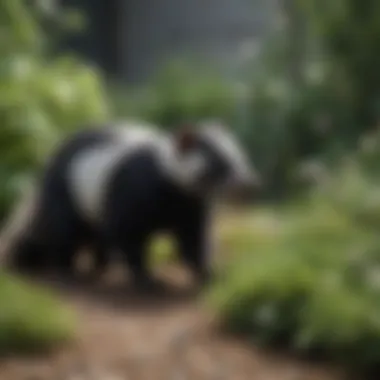Effective Strategies for Repelling Skunks from Your Yard


Intro
Skunks can be a nuisance for homeowners and gardeners alike. Their nocturnal behavior, coupled with the distinct odor they bring, makes it crucial to explore effective strategies to keep them away from residential yards. Understanding skunk behavior and habitat preferences is key to creating a skunk-free environment.
This guide aims to provide comprehensve and humane strategies for repelling skunks while sustaining the health of your outdoor space. From prevention techniques to effective deterrents, each aspect is carefully designed to cater to the needs of homeowners and gardening enthusiasts.
By the end of this article, readers will gain insights into the best practices for keeping skunks at bay and maintaining a serene, skunk-free yard.
Understanding Skunk Behavior
Understanding the behavior of skunks is crucial in developing effective strategies for keeping them out of your yard. Skunks are often perceived as nuisances, yet their behavior offers valuable insights that homeowners can leverage. By recognizing their habits and preferences, one can implement targeted measures to deter them effectively.
Characteristics of Skunks
Skunks are medium-sized mammals belonging to the family Mephitidae. They are most recognized for their distinctive black and white fur, though there are variations, such as the spotted skunk. Typically, skunks can measure around 20 to 30 inches long, including their bushy tails.
One defining trait of skunks is their ability to spray a foul-smelling liquid as a defense mechanism. This spray can reach up to twelve feet away and is composed of sulfur compounds. Their nocturnal nature often leads to increased activity during the night, allowing them to forage with relative safety. Skunks have sharp claws that enable them to dig for food, which usually consists of insects, small vertebrates, fruits, and vegetables.
Understanding these characteristics can help detect their presence and formulate appropriate repellents.
Common Reasons Skunks Invade Yards
Skunks may enter residential yards for several reasons. Understanding these motivations can inform efforts to repel them effectively. Skunks generally seek food, shelter, or a safe nesting area.
Here are some common attractants for skunks:
- Food Sources: Skunks are opportunistic feeders. Pet food left outside, fallen fruits, and unsecured garbage cans present enticing opportunities for skunks to wander into yards.
- Shelter: Skunks often look for places to raise their young or rest. Areas with thick vegetation, woodpiles, or under decks can provide favorable conditions for these animals.
- Open Access: Unfenced yards or gaps under fences can allow easy access for skunks. Their burrowing ability makes it essential to have secure boundaries in place.
By recognizing what lures skunks into the yard, homeowners can mitigate these factors and take action to prevent future invasions. Addressing food sources and providing less attractive shelters are solid steps towards maintaining a skunk-free environment.
Assessing Your Yard
Assessing your yard is a crucial step in preventing skunks from establishing a presence. This process involves a thorough examination of what may be attracting these animals and how your yard functions as a habitat. Understanding the environmental conditions and resources available can significantly aid in skunk deterrence strategies. Homeowners can benefit greatly by recognizing the unique characteristics of their properties and making informed decisions to minimize invitees like skunks.
Identifying Attractants
To effectively deter skunks, it is essential to recognize what attracts them to your yard. Skunks are omnivores, meaning they will eat both plants and small animals. Here are common attractants to look out for:
- Open Garbage: Skunks often rummage through unsecured trash cans or compost heaps. Ensure that waste is properly stored in sealed containers.
- Pet Food: Leaving pet food outside, especially during the night, can be a quick invitation for skunks. Instead, feed pets indoors or remove food from outside once your pets are done eating.
- Bird Feeders: Seeds can attract various wildlife, not just birds. Ensure feeders are not spilling seeds on the ground, as this can entice other animals.
- Fallen Fruit: If you have fruit-bearing trees, be diligent about removing any fallen fruit. This can be a significant draw for skunks looking for an easy meal.
By minimizing these attractants, you reduce the reasons for skunks to visit your property.
Understanding Your Yard's Ecosystem
A holistic approach to assessing your yard includes understanding its ecosystem. Every yard has its unique balance of flora and fauna, and this can influence skunk activity. Here are some elements to consider:
- Vegetation Type: Dense vegetation or shrubs can provide shelter for skunks. Keep landscaping tidy and prune overgrown areas to eliminate hiding spots.
- Water Sources: Skunks require water, and standing or stagnant water can attract them. Remove or manage sources of puddles or water features as needed.
- Local Wildlife Interactions: Consider the overall wildlife presence. If you notice a diversity of animals frequenting your yard, skunks may be hunting them as food sources. Encouraging a balanced ecosystem can help manage this.


By analyzing these factors, you can create a less appealing environment for skunks while promoting biodiversity and maintaining your garden's health.
Incorporating these assessments into your yard care routine can lead to a better understanding of how to effectively repel skunks.
Preventive Measures
Preventing skunks from invading your yard requires a proactive approach. Effective preventive measures are crucial as they directly influence the likelihood of skunks entering your space. Understanding which attractants you may have and modifying your environment can deter skunks and protect your property.
Securing Garbage and Compost
One of the most important steps in keeping skunks away is securing garbage and compost. Skunks are opportunistic feeders and will seek out easy food sources. Ensure that all trash cans are tightly sealed. Consider investing in containers specifically designed to keep wildlife out.
- Use locking lids: This adds an extra layer of security against curious skunks.
- Store containers away from sight: Placing garbage bins in enclosed areas or sheds reduces the chance of skunks discovering them.
Composting can also attract skunks if not well managed. If you compost, make sure to use a sealed bin. Skunks are drawn to food waste, including fruit scraps and vegetable peels. Removing potential food sources will discourage skunk visits.
Utilizing Fencing Strategies
Building a proper fence is another effective preventive measure against skunks. A well-designed fence can serve as a barrier, keeping unwanted wildlife at bay. When erecting a fence, consider the following factors:
- Height: The fence should be at least three feet tall to prevent skunks from jumping over it.
- Depth: Dig the fence a few inches into the ground to discourage burrowing.
- Material: Solid fencing is preferable since skunks can maneuver through gaps in chain-link types.
Regularly inspect the fence for any damages or gaps that could allow wildlife access.
Managing Pet Food Sources
If you have household pets, it is essential to manage their food sources effectively. Many pet owners unknowingly attract skunks by leaving pet food outdoors. To minimize the risk:
- Feed pets indoors: This eliminates the possibility of attracting skunks to your yard at night.
- Remove uneaten food: If you must feed pets outside, monitor their feeding times closely and take away any leftovers promptly.
Pet bowls should not be left out overnight to further reduce attractants.
Creating Environmental Barriers
Creating environmental barriers can either deter skunks or make your yard less appealing. This can be done through a combination of landscaping and additional physical barriers.
- Use raised garden beds: Skunks may be less inclined to enter elevated spaces.
- Implement motion-activated lights: Bright lights can startle skunks, encouraging them to leave the area.
- Install gravel or mulch: These materials can serve as barriers, making it less appealing for skunks to dig.
By combining these techniques, homeowners can create a less inviting environment for skunks. Regular maintenance of the yard also plays a key role in showcasing a space that is less hospitable to wildlife.
Natural Deterrents
Importance of Natural Deterrents
Natural deterrents play a crucial role in repelling skunks from residential areas. They offer a more humane solution compared to traps or lethal methods. This approach aligns with eco-friendly practices. Homeowners who are concerned about nature's balance can utilize natural deterrents to maintain control over their gardens without harming wildlife. Furthermore, these methods are often easier to implement and less hazardous than chemical options.
Essential Oils as Repellents
Essential oils can effectively deter skunks. Oils like peppermint, citronella, and eucalyptus produce strong scents that skunks dislike. Not only do these oils offer a pleasant aroma for humans, but they also serve a purpose in keeping unwanted animals at bay. To use essential oils, homeowners can mix a few drops with water in a spray bottle and apply it to areas where skunks are likely to enter. This method can be reapplied after rainfall or at consistent intervals to maintain effectiveness.


"Using natural scents can create a barrier, encouraging skunks to find another location."
Plants that Repel Skunks
Certain plants possess characteristics that make them unappealing to skunks. For example, marigolds, lavender, and strong aromatic herbs can act as natural barriers. Planting these species around the perimeter of the yard not only beautifies the space but can also minimizes skunk presence. These plants thrive in various conditions and can blend seamlessly into existing gardens, proving both functional and decorative. Additionally, choosing native plants may enhance biodiversity without inviting unwanted pests.
Using Vinegar and Spices
Household items like vinegar and spices can also be utilized to repel skunks. The strong smell of vinegar is particularly effective at deterring them. Homeowners can soak rags in vinegar and place them in areas where skunks frequent. Similarly, spices such as cayenne pepper can be sprinkled around the yard. The potent odors disrupt the skunks' sense of smell, discouraging them from approaching. Care should be taken to reapply these substances regularly, especially after rain, to ensure their effectiveness.
Commercial Products
In the realm of skunk management, commercial products serve as significant tools for deterring these nocturnal visitors from invading your yard. This section emphasizes the importance of utilizing these products while also understanding their advantages and potential downsides, with the aim of maintaining a balance between human needs and wildlife preservation.
Evaluating Skunk Repellents
When assessing skunk repellents, homeowners must consider several factors. First, effectiveness is paramount. Different skunk repellents vary in how successfully they deter skunks. Some products may utilize strong odors or specific ingredients that create an unwelcoming environment for skunks. For example, certain brands may use predator urines, which simulate the presence of natural enemies, thus causing skunks to avoid the area.
Additionally, the longevity of the repellent's effects is crucial. Some products require frequent reapplication, especially after rain or heavy irrigation, while others claim prolonged protection.
Moreover, you should ponder safety for pets and children. Many commercial repellents contain chemicals that may pose risks to non-target species. Therefore, opt for products with clear labeling regarding their safety for use around households.
In summary, the evaluation of skunk repellents should include their effectiveness, durability, and safety. Test various options and read reviews to determine which products align with your specific needs.
Safe Use of Chemical Deterrents
The use of chemical deterrents presents certain considerations to ensure the safety of all users and adjacent wildlife. To start, it is crucial to adhere to the instructions provided on the product packaging. Misuse could lead to unintended consequences, such as harm to desirable animals or environmental damage.
One must also consider the application technique. Spraying in areas where pets or children frequently play can increase risks. It's wise to apply deterrents during low-activity hours, such as in the late evening or early morning, to minimize contact.
Furthermore, consider the weather conditions before application. Rain can wash away many chemical repellents, diminishing their effectiveness. For dry spells, the application may be more successful. Therefore, plan accordingly. Always keep an eye on surrounding flora and fauna; some chemical deterrents might damage plants or repel beneficial insects.
In summary, using chemical deterrents safely involves proper application, timing, and consideration of the local environment. Taking these precautions leads to a more effective and responsible way of managing unwanted skunk activity.
Trapping and Relocation
Trapping and relocation of skunks is a crucial component of managing skunk populations in residential areas. Implementing humane trapping techniques is both ethical and effective in addressing skunk issues without causing harm. This approach allows for the safe removal of skunks while ensuring that local wildlife is treated with respect.
The benefits of trapping skunks include immediate relief from invasive behavior and potential damage to gardens or properties. Moreover, relocating skunks to a suitable habitat not only helps restore balance in your own yard but also contributes positively to the ecosystem by ensuring the skunks find a suitable environment away from urban settings. However, careful consideration is essential when choosing to trap and relocate, as it involves understanding more than just the action of trapping itself.
Humane Trapping Techniques
Humane trapping requires specific techniques to ensure the skunk is captured safely without injury. The following guidelines can help homeowners effectively implement humane trapping:
- Choose the right trap: Use a live trap, like the Havahart trap, designed for skunks. These traps have a mechanism that ensures skunks cannot escape once inside.
- Baiting effectively: Skunks are attracted to various foods. Common baits include peanut butter, cat food, or tuna. Place the bait deep within the trap to encourage the skunk to enter fully.
- Location matters: Set traps near areas where skunks are active or where signs of their presence are evident, such as digging marks or droppings. Also, place traps away from noise or potential disturbances.
- Monitor periodically: Check traps frequently to minimize the animal's stress. Leaving a trapped skunk in the trap for extended periods can induce panic and health risks.
Effective trapping not only relies on the trap but also requires patience and consideration.


Regulations on Skunk Relocation
Understanding local regulations surrounding skunk relocation is crucial. Many jurisdictions have specific laws governing how and where skunks can be relocated. Here are key points to consider:
- Check local laws: Before trapping, research state or local wildlife regulations. Some areas may require permits for trapping or dictate specific locations where skunks can be released.
- Avoid urban areas: Relocating skunks to residential or urban zones is typically discouraged. These areas may not have sufficient resources for the skunks and can lead to new conflicts.
- Designated wildlife areas: Relocation efforts are best suited for designated wildlife habitats or reserves where skunks can thrive without causing issues.
- Consider professional help: When in doubt, contacting wildlife control professionals can provide clarity. They are informed about regulations and have experience in humane trapping and relocation.
Taking these considerations into account will ensure that skunk trapping and relocation are conducted ethically and within legal parameters.
Long-Term Management Strategies
Long-term management strategies are crucial for effectively repelling skunks from your yard. Skunks are adaptable creatures, so relying solely on short-term solutions often proves ineffective. By adopting a holistic approach, you can create an environment that is less appealing to skunks in the first place.
Implementing ongoing strategies entails continuous monitoring of your yard and adapting your methods as necessary. Understanding the habits and behavior of skunks enables homeowners to stay one step ahead. This foresight can lead to not just fewer skunk encounters, but also to a more harmonious coexistence with local wildlife.
Monitoring Skunk Activity
Monitoring skunk activity is an instrumental tactic in long-term management strategies. It involves observing signs of skunk presence, such as tracks, burrows, or droppings. Noticing these markers can help you identify patterns in skunk behavior. In addition, taking note of the time of day when skunks seem most active can inform your management strategies. At dusk or dawn, skunks are typically on the move. More effective measures can then be implemented during these peak activity times.
Another valuable method is to set up cameras to gather insights into skunk habits. This data can provide you with a clearer picture of their movements and interactions with other animals in your yard. Additionally, maintaining a journal of your findings can reveal trends over seasons, offering a broader context for seasonal behaviors. The effort spent on monitoring will pay off by allowing for timely interventions when skunks become more frequent visitors.
Evaluating the Effectiveness of Methods
Evaluating the effectiveness of methods used to repel skunks is equally important. After implementing strategies, wait for a certain period to assess their impact. Review how often skunks return and whether the methods in place are changing their behavior. Keep track of both successful and unsuccessful tactics and analyze the data. Doing so allows you to refine your approach over time.
One way to evaluate is through direct observation. Have you noticed a decrease in skunk sightings or evidence of their activity? In addition, solicit feedback from family members or neighbors regarding any changes they have noticed. Their observations may offer insights that are not immediately apparent to you.
Moreover, if you have deployed commercial products, consider their influence on skunk activity and other wildlife in your area. Take note of the effectiveness of natural deterrents versus chemical ones in repelling skunks.
"A strategic blend of monitoring and evaluation forms the backbone of a robust long-term management strategy for skunks."
In summary, successful long-term management requires an understanding of skunk behavior and a commitment to ongoing observation and evaluation. By being proactive, you can sustain a skunk-free environment while also promoting an attractive and healthy yard.
Ending and Key Takeaways
In understanding how to effectively repel skunks from your yard, it is crucial to synthesize the information presented throughout this guide. Skunks, while often perceived as a nuisance, play a role in the ecosystem. However, their presence in residential areas can lead to potential issues such as damage to gardens and the risk of sprays if they feel threatened.
Recap of Strategies
This article outlined a variety of effective strategies to deter skunks, including:
- Understanding Skunk Behavior: Recognizing their habits and preferences can give you insight into why they may be attracted to your yard.
- Assessing Your Yard: Identifying attractants such as food sources and potential hiding spots helps in making your yard less inviting.
- Preventive Measures: Securing garbage, ensuring pet food is managed, and creating physical barriers are all critical steps.
- Natural Deterrents: Employing essential oils, certain plants, and household items like vinegar can keep skunks at bay without harmful chemicals.
- Commercial Products: A selection of repellents is available, with specifics on evaluating their safety and effectiveness.
- Trapping and Relocation: Understanding humane trapping options and local regulations ensures that if intervention is necessary, it is done responsibly.
- Long-Term Management Strategies: Monitoring skunk activity will help in assessing the effectiveness of your methods and make adjustments as needed.
By recap on these strategies, homeowners can take more informed actions to keep their yards skunk-free, promoting a more pleasant living environment.
Final Recommendations
Ultimately, the key to repelling skunks lies in consistent practice and awareness. It is advisable to combine several strategies for maximum effect. Here are some final recommendations:
- Stay Informed: Regularly update yourself on best practices for wildlife management. Websites like Wikipedia or Britannica provide reliable information.
- Community Engagement: Consider discussing with local neighbors, as a community approach can create a more united front against skunks.
- Observations Matter: Always note changes in skunk activity. If methods are not working, be prepared to rotate them or try new ones.
- Humane Options First: Whenever possible, prioritize humane solutions over harmful ones. This not only protects skunks but also maintains the ecological balance in your area.
By implementing these methods along with constant evaluation of their effectiveness, you can achieve a skunk-free yard and enjoy your outdoor space once again.
"Consistency is key in wildlife management to create an environment that's unattractive to pests."
Regular maintenance and vigilance will play a significant role in achieving and maintaining a skunk-free yard.















